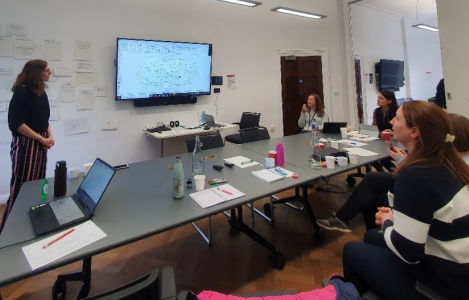
Participatory System Dynamics Modelling (Causal Loop Diagrams)
A series of participatory modelling activities were carried out to build causal loop diagrams (CLDs) around the identified shared concern to capture the system boundaries for each group of stakeholders, including residents, housing developers and local planning authorities.
UCL Team
Author
Contact UCL Team
Email
Details
Thamesmead is characterised by a rich network of parks spreading over 150 ha of green space and 32 ha of water, consisting of 5 lakes, 7 km of canals, 5 km of Thames waterfront, plus 14 sites of nature conservation interest. However, Thamesmead is currently affected by numerous vulnerabilities too. With only a third of adult residents in full-time employment, Thamesmead represents one of the most deprived neighbourhoods in England, with significant child poverty and about 40% of the population living in privately or socially rented accommodations
Participatory modelling encompasses various forms of collaboration among practitioners, academics, and other stakeholders who engage in a purposeful learning process. In Thamesmead, our work aimed to use a Participatory SD modelling process as a mechanism to enhance stakeholders’ mutual learning and co-produce novel knowledge on the use and management of natural spaces. This process is key to understand stakeholders’ perspectives and priorities and to model and analyse urban development interventions at the systems level.
This part of the work builds on the previous step from the section Developing a Shared Concern. We carried out a set of workshops aimed to build several causal loop diagrams (CLDs) around the selected shared concern; each CLD represented the perception of the system boundaries for a group of stakeholders. We conducted these workshops in person or online, going through a round of variable elicitation with each stakeholder group before discussing the cause-and-effect relationships that stakeholders perceived between these variables. This resulted in CLDs of the shared concern for each stakeholder group, which could then be compared in the next step (see Comparing Qualitative Models ).
This work was co-funded by the CUSSH (Complex Urban Systems for Sustainability and Health) and CAMELLIA projects.
Keywords:
Workshops; Stakeholders; Participatory System Dynamics; Causal Loop ; Participatory modelling; Causal loop diagrams, System dynamics; Decision-making; Shared-concerns; Stakeholders; Systems thinking
Links:
- Zimmermann N., Pluchinotta I., Salvia G., Touchie, M., Stopps, H., Hamilton, I., Kesik, T., Dianati, K., Chen, T. (2020). Moving online: reflections from conducting system dynamics workshops in virtual settings. System Dynamics Review. https://doi.org/10.1002/sdr.1667 ❐
- Pluchinotta I., Salvia G., Zimmermann N., (2022). The importance of eliciting stakeholders’ system boundary perceptions for problem structuring and decision-making, European Journal of Operational Research, 302(1) https://doi.org/10.1016/j.ejor.2021.12.029 ❐